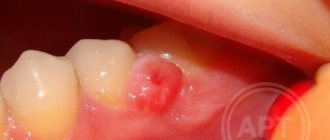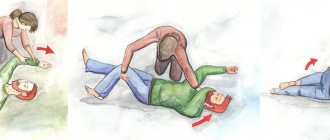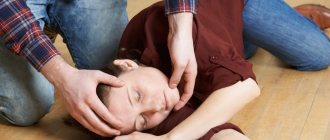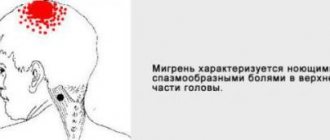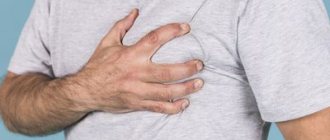Traumatologist-orthopedist
Shelepov
Alexander Sergeevich
12 years of experience
Doctor
Make an appointment
An accumulation of clots or liquid blood in the soft tissues of the body, formed due to rupture of blood vessels, is called a hematoma. The most common type of pathology is an ordinary bruise. However, this concept includes much more severe and complex cases that cannot be left without qualified medical care. Blood flowing from the vessel irritates the tissues surrounding it, resulting in pain, tissue swelling and other signs of developing inflammation. In addition, the hematoma compresses the tissues or organs located next to it, which can lead to the development of complications.
Why does a lump appear?
A bump on the head from a blow appears due to damage to small vessels. At its core, it is a type of hematoma. Upon impact, the capillaries rupture and blood flows out. When other parts of the body are bruised, a bruise appears on the skin, but there is usually no swelling. This is due to the fact that the subcutaneous tissue absorbs blood on the body and limbs. Therefore, swelling does not form.
There is no fiber on the head. Blood pours out under the skin. In this case, the liquid is not absorbed, but only accumulates. For this reason, a head injury leads to the appearance of a lump. This does not exclude the simultaneous formation of a bruise if the blow was strong enough.
Examination methods
To diagnose hematomas, you need to contact a traumatologist. When the hemorrhage is localized deep in muscle tissue, joints or internal organs, a visual examination provides too little information for the doctor to objectively assess the severity of the lesion and the degree of danger of injury. In such situations, the patient is prescribed:
- Ultrasound of a damaged body part, organ or joint;
- X-ray of the damaged part of the body;
- CT or MRI;
- puncture (puncture with a special needle) of a joint or organ in which blood is believed to have accumulated.
Based on the examination results, the doctor prescribes appropriate procedures.
Causes
A hematoma on the head does not occur with every bruise. In order for a lump to appear, a fairly rough mechanical effect on the skin is necessary. Swelling usually occurs as a result of the following injuries:
- Bumps on a child’s head from an impact are most often caused by falls. Small children often fall out of strollers. Such injuries also occur when a child learns to walk.
- Adults are more likely to get bumps when hitting hard surfaces. This happens with awkward movements or when an object falls on a person from above.
Symptoms
How to distinguish a hematoma from other types of edema and tumors? Bumps on the head from a blow have the following features:
- A hematoma always forms exclusively in the place that has been subjected to mechanical stress. For example, if a person hurts himself on the top of his head, the bump cannot appear in the frontal region.
- The size of the formation may vary. It depends on how severe the bruise was.
- The color of the cone may vary. Sometimes it does not differ from the rest of the skin color, but it may also be bluish due to hemorrhage. But in the head area there are no bruises of such a bright color as on other parts of the body.
- The skin around the lump looks swollen.
- When you press on the lump, pain is felt.
On average, swelling can last from 2 to 7 days. With intensive treatment and proper first aid, the lump goes away quite quickly.
How to remove hematomas?
After establishing the nature and characteristics of the hematoma, treatment is prescribed in accordance with the information received:
- prescribe UHF procedures;
- a surgical opening is performed to remove accumulated clots and rinse the cavity;
- the patient is hospitalized in the surgical department for opening and drainage, followed by antibiotic therapy.
Recovery time depends on the extent of the lesion, the presence or absence of infection and other factors.
Features of bruises in children
A bump on the head after a blow in a child is a very common occurrence. After all, children love a mobile and active lifestyle. Babies have delicate scalp, so a hematoma can form even with a minor blow.
However, head injuries in children are often accompanied by concussion and other unpleasant consequences. Therefore, you need to pay attention to the baby’s well-being. Many children cry a lot when they are bruised, but most often this is due to fear rather than pain. You need to let the baby calm down, and then take a closer look at his condition. If you have the slightest doubt, you should contact a pediatric traumatologist.
The size of the hematoma does not always indicate the danger of injury. For example, with forehead bruises, huge bumps always form. However, the frontal bone is the strongest and protects the brain well, so unpleasant consequences from bruises in this area are rare.
Cold
Let's say that a child or adult has a bump on their head from a blow. What to do first? A few minutes after the injury, blood continues to flow from the burst vessels, and the lump grows. If the blow was very strong, then the swelling increases right before our eyes.
First of all, you need to stop the subcutaneous hemorrhage. To do this, apply cold to the damaged area. Its effect will help narrow blood vessels and reduce hematoma, as well as reduce pain. The following available tools are suitable for this purpose:
- Ice. If the injury occurred at home, you can take ice from the refrigerator, put it in a bag and wrap it in a towel. Apply an ice compress to the bruised area. This procedure must be repeated several times during the day. Instead of ice, you can use freezer items or a bottle of cold water.
- Compress with cold water. You need to moisten the cloth with cold water and apply it to the bump. As soon as the compress warms up, it must be replaced. This procedure is repeated several times.
- If you don’t have anything cold on hand, regular vegetable oil can help. It should be applied to cotton wool or a bandage and applied to the bruise for half an hour. With the help of such a folk remedy, you can completely avoid the appearance of a bump if the blow was not too strong.
Cold must be applied within the first 24 hours after injury.
Why does a hematoma change color?
Doctors identify three distinct stages of a hematoma through which it must go before completely disappearing. Each of them is characterized by a certain skin color, through which the hemorrhage is visible.
- Appearance of a bruise. Immediately after a soft tissue bruise, a sharp pain is felt, the area of skin in the damaged area becomes purplish-red and swells due to tissue swelling, then the red color gradually changes to blue. The red color comes from red blood cells containing large amounts of hemoglobin. After a few hours, hemoglobin begins to break down, and the bruise site turns blue. Due to swelling and inflammation of the tissue in the damaged area, the temperature rises.
- Greening. After two or three days, swelling and temperature decrease, the condition of the tissues more or less returns to normal, but minor pain when pressed remains. The blue tint of the skin gradually turns into a greenish color.
- Yellowing. By about the fifth day, the swelling completely disappears, the remaining hemoglobin disintegrates and is removed from the tissues. The site of the bruise becomes yellowish, then acquires its normal color.
Visual symptoms of hematomas are most clearly visible in cases where the effusion of blood occurs in the subcutaneous layer. If a clot forms in the deeper layers of soft tissue, then only a small but painful swelling is noticeable on the outside. Such formations are much more dangerous, since the process occurs unnoticed and can be accompanied by complications.
Are you experiencing symptoms of a hematoma?
Only a doctor can accurately diagnose the disease. Don't delay your consultation - call
Exposure to heat
Cold is a first aid remedy for bumps on the head from a blow. How to treat the hematoma further? Many people limit themselves to only cold compresses on the first day. However, this is not enough. On the second day, the sore spot must be warmed up. Under the influence of heat, the swelling subsides and the lump begins to dissolve.
You can apply a warm boiled egg to the bruise. Table salt, heated in a frying pan and wrapped in a cloth, is also suitable. You should not use compresses that are too hot, so as not to burn your already injured skin.
In the following days, the lump is treated with pharmaceutical ointments or folk remedies.
Frequently asked questions
How to get rid of a hematoma using traditional methods?
Folk remedies only help with minor and non-dangerous superficial damage. To speed up resorption, you can apply a compress of mashed cabbage leaves, bodyagu mixed with Vaseline, or tampons soaked in a mummy solution to the bruise. For deep or extensive injuries, you should consult a doctor.
Why is a hematoma dangerous?
The greatest danger to health, and sometimes to life, are hematomas that form deep in the tissues, inside organs or joints. Large hemorrhage is dangerous due to the possible development of infection, inflammation and suppuration. If the joint is damaged, bursitis, synovitis or hemarthrosis may develop, resulting in disability. Blood in the peritoneal cavity leads to peritonitis. Brain hematomas lead to dysfunction of this organ with serious consequences in the form of deterioration of cognitive functions, paralysis of body parts, etc.
How to treat a hematoma in the first hours after injury?
Immediately after a bruise, it is necessary to provide first aid to the victim: apply ice to the injured area, then tightly bandage the injured limb to block the flow of blood into the tissue. The dressing should not remain on for more than two hours. During this time, it is necessary to get to the emergency room, where the patient will receive the necessary professional help.
Ointments
How to anoint a bump on the head from a blow after first aid? In pharmacies you can buy various local remedies for bruises. Let's look at some of them:
- "Troxerutin." This is a drug in the form of a gel that helps resolve swelling after a bruise. The product is well absorbed into the skin, but it is not recommended to apply it to damaged epithelium. The treated sore spot should be protected from exposure to ultraviolet radiation.
- "Troxevasin". The gel strengthens the walls of damaged blood vessels and promotes their healing. It reduces swelling and relieves pain. The cone should be treated with gel in the morning and evening.
- "Rescuer". This gel stops the inflammatory reaction and heals the injured area of the skin. In addition, it has disinfectant properties.
- "Heparin ointment." The product is intended to combat thrombosis. However, it is also effective for bumps on the head from a blow. The ointment acts as an anticoagulant and promotes the resorption of hematomas.
- "Lyoton 1000". This gel also has anticoagulant properties and dissolves blood mass under the skin after a bruise.
- "Mirralgin." The product is a plant-based balm. It improves blood circulation in damaged tissues, relieves pain and swelling. This harmless herbal remedy is especially indicated for young children.
These medications must be used until the lump disappears completely. Treatment may take varying periods of time, depending on the severity of the injury.
Treatment of a bump on the head from a blow using medications
The bruised area can be lubricated with special ointments. They improve lymph and blood flow from the site of injury and thereby help the lump to resolve faster. The following are used as ointments:
- Troxevasin;
- Lyoton-2000;
- Heparin ointment;
- Troxerutin;
- Rescuer;
- It is recommended to use pharmacy Badyaga.
Magnesium will help remove any congestion on the body. Prepare a compress as follows: fold the gauze in several layers, open the ampoule of magnesia and moisten the gauze. Place the cones in place and cover the top with cellophane or parchment paper. This creates a greenhouse effect. The compress needs to be left on for about 5–10 hours.
Folk remedies
Bumps on the head from a blow can also be cured using folk remedies. Everyone knows the wound-healing properties of aloe and Kalanchoe juice. These plants can be used to make a compress that will help reduce tissue swelling. You need to take a leaf of the plant, remove the top layer from it, put it on the sore spot, and then cover it with film and cotton wool. The compress is kept for about 2-3 hours.
You can use regular cabbage leaves. They need to be crushed and boiled in milk. Then put the mixture on a napkin or cloth and apply it to the bruise. Keep the compress for about 1 hour. This remedy helps relieve swelling.
Bumps on the head from a blow in adults can be treated with a mixture of iodine and alcohol (1:1 proportions). This remedy is especially useful for swelling of a bluish and pinkish color, accompanied by severe subcutaneous hemorrhage.
Further actions in case of injury
If for the first day the most correct and effective method is exposure to cold, then after this time, actions should be aimed at carefully warming up the impact site. Heat will help get rid of the swelling, relieve swelling, as a result of which the lump will resolve and disappear.
Heated salt retains heat for a long time. Wrapping it in a not very thick cloth, you need to keep the compress on the sore spot. A boiled egg will also remain warm for a long time and can be used for application.
Possible consequences
It should be remembered that a bump on the head from a blow is not always a harmless phenomenon. After all, the cranium contains the brain, many vessels and nerve nodes. Damage to these anatomical structures can lead to serious consequences:
- concussion;
- skull fracture;
- rupture of cerebral vessels.
It is important to remember that serious head injuries often lead to severe disruptions in the functioning of the central nervous system. Such pathologies often require long-term treatment. Therefore, everyone should know in what cases a lump can be dangerous.
When a doctor's help is needed
It is necessary to consult a doctor if the bump on the head after the blow does not go away within a week. If swelling does not disappear for a long time, this may indicate trauma to the bone tissue.
Seek immediate medical attention if a child or adult experiences the following symptoms:
- pain in the head and neck area;
- dizziness;
- nausea and vomiting;
- blurred vision;
- strabismus;
- discharge of blood or clear fluid from the nose or ears;
- increase in pain syndrome;
- disorders of speech and consciousness;
- pain that increases when turning the head;
- seizures;
- bleeding from the wound that does not stop for more than 10 - 15 minutes.
These warning signs may indicate a severe head injury. It is necessary to put the patient to bed, call an ambulance and monitor his consciousness and breathing until the doctors arrive.
Is a lump always associated with a bruise?
A soft bump after a head hit is not dangerous if there are no signs of trauma to the brain or bones of the skull. It is important to remember that a hematoma from a bruise never has a solid structure. If the lump looks like a lump, it is most likely not related to an impact.
Very often, people associate tumors on the head with the fact that they accidentally hurt themselves. However, such bumps may have a completely different origin.
The following formations may occur in the forehead and scalp area:
- Atheromas (wen). They look like balls filled with greasy contents. Festering wen can be painful.
- Hemangioma. This tumor of blood vessels is very similar to a lump after a bruise. However, such a neoplasm has a more intense color than a regular hematoma.
- Fibroma. The tumor consists of connective tissue and is benign. With trauma, malignant degeneration is possible.
- Lymphadenitis. In children, lymph nodes often become enlarged due to inflammation and infections. They look like red, painful bumps. They are usually located on the back of the head or behind the ears.
The appearance of a bump on the head should not be associated solely with the blow. Many of the above tumors require surgical removal. Therefore, if you are not sure that the lump is caused by a bruise, then you need to consult a specialist. Only a doctor can determine the exact cause of the tumor.
Diagnosis of hallux valgus deformity
A general practitioner, podiatrist or orthopedist will determine the main signs of the disease by visual examination and palpation of the affected foot. During an external examination, the specialist notes that the patient rests on the floor not with the outer edge of the foot, but with the entire surface. The longitudinal axis of the foot is curved, and the heel is deflected outward.
When bringing the legs together in a standing position, the patient cannot bring the heels together. In the later stages of the development of the disease, a protruding bone of the thumb is already noticeable, and swelling and redness in the joint area are noted.
To confirm the diagnosis, hardware diagnostics are prescribed - plantography, radiography of the feet and podometry. On X-rays, with the development of hallux valgus, a decrease in the height of the arch of the foot is noted, as well as a violation of the relative position of the fore, middle and rear parts of the foot.
Podometry allows you to identify uneven distribution of load with a shift to the area of the forefoot. To determine the reasons for the development of pathology, the patient may additionally be prescribed a consultation with the following doctors: neurologist, neurosurgeon, endocrinologist, gynecologist.
